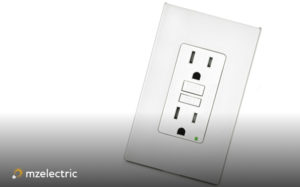Are GFCI Outlets Required in Bathrooms?
When it comes to your home’s safety, there’s almost nothing that homeowners won’t do to protect their investment—and their family. One of the simplest and most essential ways to keep your home’s electrical system safe is with GFCI outlets.
The National Electrical Code (NEC) initially mandated these simple safety devices in the early 1970s for outdoor outlets, and it continues to require them today. However, over time the requirements have expanded to include other areas of your home, including bathrooms.
But what are GFCI outlets, exactly? And how do they protect you and your home from short circuits in your electrical system? Let’s take a few moments and answer some of your questions about these vital safety devices.
 What Are GFCI Outlets?
What Are GFCI Outlets?
Ground Fault Circuit Interrupters, or GFCIs, are essentially miniature circuit breakers built into outlets. These breakers are extremely sensitive to any discrepancy between the current coming into the outlet and the current that’s going out. When it detects a difference, it quickly shuts off the power to that outlet.
GFCI outlet installation prevents shocks and electrocution from these outlets, resulting from excess moisture causing short circuits. By turning off the power immediately, it prevents the extra current from rerouting and moving to your body, where it could cause severe harm.
You can tell if you have a GFCI outlet simply by looking at it. These outlets have two buttons labeled “test” and “reset,” usually between the two receptacles. The test button allows you to make sure your GFCI breaker is working correctly, while the reset button works like flipping a tripped breaker on your electrical panel, restoring the flow of current to the outlet.
The Importance of GFCI Outlet Installation
GFCI outlet installation is all about adding protection, both for you and your electronics. That is why they’re so important in areas where your outlet may be exposed to water. The moisture acts as a conduit for electricity, and in an outlet, it can cause a short circuit, meaning the current takes an unintended path.
The dangers of this electrical “leakage” are hard to overstate. Most homeowners have several electrical devices in a bathroom, many of which they use close to water. Hairdryers, curlers, flat irons, razor and toothbrush chargers, and even devices like radios, TVs, and phone chargers are often plugged into bathroom outlets that may be exposed to excess moisture.
By shutting off power the moment an electrical imbalance is detected, your GFCI outlet accomplishes two very important things:
Protects You from Shocks
A shock can occur in many ways—too much steam could seep into your outlet, or you could drop a hairdryer in a wet sink or bathtub. You are far less likely to suffer a severe shock or electrocution by immediately cutting power when this happens.
Protects Your Electronics
Short circuits can also cause severe damage to electrical devices, overloading circuits, and potentially causing fires. A GFCI outlet can help prevent damage to your electronics, shutting off power before too much damage is done. While this protection is not always perfect, a GFCI outlet gives you a much better chance of salvaging those electrical appliances.
How GFCI Outlet Installation Works
Although GFCI outlets have been required since the 1970s for outdoor areas, kitchens, bathrooms, basements, and anywhere within six feet of a water source, many older homes still lack the proper outlets to meet national and local building codes. Luckily, GFCI outlet installation is a quick, relatively inexpensive project for any qualified electrician.
When you contract an electrician to install GFCI outlets in your home, they’ll make sure to note any outlets that need to be replaced to ensure that your home is not only up to code but is as safe as possible. They’ll then work outlet by outlet, turning off power to each area before replacing the old outlet with a new, safer model.
Your technician can also advise on ways to get the most out of your GFCI outlets. That is especially useful when it comes to avoiding nuisance tripping, where your GFCI switches your outlet off repeatedly, leaving you to reset your outlet constantly. To prevent these unnecessary trips, be sure to avoid:
- Overloading a GFCI outlet
- Installing a cable more than 100’ long
- Excess moisture, including an outlet too close to a water source
- Plugging fluorescent lighting into a GFCI outlet
Another common reason for nuisance tripping is poor installation, so you should avoid attempting GFCI outlet installation yourself and leave the job to the professionals.
Expert Electrician Near Me in Littleton, CO
When it comes to electrical services in Littleton, CO, and the rest of the Denver area, MZ Electric has the training and the experience you can rely on to get the job done right and keep your appliances and your household safe. Our team of expert electricians has serviced homes throughout the area. Whether you’re installing a GFCI outlet or upgrading your electrical panel, contact MZ Electric today to schedule your next service!
